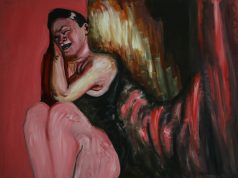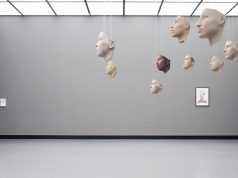By Yevgeniya Selezneva, participant of The Odessa Review journalism seminar and workshop
Today, when speaking of art, we shouldn’t become distracted by paying too much attention to insignificant scholarly aspects of the work, such as whether the artist follows the rules of academic technique. Since generally art can be described through its formal criteria, the most important question to ask in determining the meaning of the work is “what kind of sensation does it create?” This is doubtlessly the main way to determine a work’s core significance.
The 20th century might yet be called the age of “Neo-Mythology.” A number of new mythologies have been created over the last century. Two of these were the twin totalitarian myths of Communism and Fascism. Incredible applications of ideology were used to bring these golems to life. In fact, during the existence of the two regimes, art was leveraged for the purposes of refashioning the soul of man. Art, it might be said, was made to slough off its core task of supplying and embodying meaning for the human soul, and made to serve the ends of semiotic production of social constructs. The only thing left to do for the “official” creators was to fit the muscle of the “Big Lie” and the skins of hypocrisy onto the crumbling bones of ideology.
There were, however, two possible ways of struggling against the system. The first one was to come into a firmly open confrontation with the regime. As the 1930’s had shown in both the USSR and in the Nazi Reich, this was a very brave, heroic, and suicidal path to choose. The other method of fighting the state mythology was to autonomously create one’s own, and that is what Odessa’s non-conformist artists began doing at the end of the sixties.
Most art historians posit that the Odessa non-conformist movement began with the infamous (and illegal) street exhibition of “Sychik+Khruschik.” Taking place in 1967, the exhibit was named for its two authors, Stanislav Sychov and Valentine Khrusch. That exhibition took place on the fence of the Odessa Opera Theater and lasted for a full 180 minutes before being shut down by the authorities. Incredibly, this was seven years before the legendary “bulldozer exhibition” took place in Moscow.
Anyway, such brave and beautiful actions were a relative rarity. The everyday reality of an Odessan non-conformist artist was the lonely and silent process of working at home, and only meeting one’s allies from time to time at some home exhibitions and concerts. Years without the possibility of a legal exhibition, neglect by the state-supported colleagues and almost total anonymity were the price for saving one’s inner core during this époque.
Heroes should always be named. The Odessan Non-conformism artists included such prominent figures as Valentine Khrusch, Lyudmila Yastreb, Victor Marenyuk, Volodymyr Strelnikov, Alexander and Margarita Anufriyev, Valery Basanets, Stanislav Sychov, Oleg Sokoloff and Volodymyr Tsyupko. Not all of them were trained as painters in the art schools – many had been excluded from the universities because of their political opinions.
The group’s creations were quite various and heterodox. Trying to find themselves in figurative, abstractionist and conceptualist directions, they never lost the connection to their primordial roots, using Ukrainian folklore and elements of the wider world’s culture legacy to develop their own symbolic language. However, what distinguished these Odessites from their peers in the Soviet Union underground, like those in Moscow, was the absence of any political aspect to their work.
Unfortunately, many members of the movement migrated or died before the late 1980’s when Perestroyka came. The tale of Odessan Non-conformists cannot be described as a tale with a happy ending. By the end of the 1970’s the artists began to be spoken about outside the borders of the Soviet Union and started to be invited to take part in exhibitions, as well as to be included in art catalogues.
So, what makes Odessan non-conformists so important today, and for Ukrainian art history, and what led their modest struggle to succeed? In our age of Neo-Mythology, art also takes on certain aspects of myth within the wider sphere of ideology. The world has irreversibly changed over the last hundred years. Only myth can hold together all the structures and systems of our everyday lives. The usual, non-mythical perception works no more when it comes to such monsters as the Soviet Union existence, with all its ideology and twisted fairytale-like laws.



































